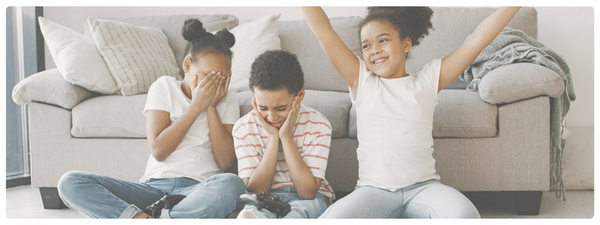We’re always listening to the Nurture community of parents, caregivers, and educators as they bring questions about screen time, online safety, and the impact of digital play on children’s mental and physical health. Then, we turn to our in-house expert, Dr. Rachel Kowert, for answers. As a research psychologist, award-winning author, globally recognized digital play expert, and parent, she guides us through the relevant science and studies.
Scroll down to sign up for the Nurture Newsletter to get the latest FAQs and the opportunity to pose your own questions.
I’m starting this off with some of the top questions around screen time for kids — more specifically, healthy or "better" screen time. This collection of FAQs will continue to expand, so come back often!
How much screen time should kids really have?
The short answer: There is no magic number.
The American Academy of Child & Adolescent Psychiatry shares guidelines like:
- No screens except video chats until 18 months
- Only educational programs with a caregiver until 24 months
- Roughly one hour per weekday or three on weekends until age 5
- No screens 60 minutes before bed
Yet, to many parents, these guidelines feel unrealistic in an increasingly busy and digital, tech-filled world. Since every child and environment is unique, it’s worth repeating: There is no magic number for how much screen time kids should have.
The AACAP recognizes, as do I, that as your child gets older, we can give them fewer restrictions on screen time. For example, when my daughter was three, I limited her screen time and was very prescriptive in what she was doing with those screens. The majority of her screen time was spent video chatting with her Nonna and watching Sesame Street.
Now that she has reached double digits in age, my daughter certainly uses screens more than she did before, both at school and at home. She also embraces more flexibility in what she does with her screen time — and I’m happy to report she still video calls Nonna regularly!
What’s most important to keep in mind as children develop is balance. Our kids will start to be more interested in establishing independence and autonomy, especially in how they spend their time. Our job as parents is to help them understand a healthy balance of screen and non-screen activities.
Building good habits from a young age and modeling good habits ourselves will set kids up for more thoughtful use of screens to enhance their lives. For example, at Nurture we teach life skills through digital play.
What happens when kids get too much screen time?
Too much of anything might lead to undesirable outcomes. Let’s recognize the challenges we might encounter, plus any signs that screen time or autonomy may need an adjustment.
For example, it’s well documented that screen time close to bedtime can disrupt sleep for kids and their parents, too. There are also significant concerns around eye health, such as eye strain and dry eyes.
Temporary mood changes are also common (as most parents can attest!). There are a range of reasons why too much screen time can lead to bad moods, such as fatigue or overstimulation.
Yet there’s good news for parents and kids: These challenges are temporary. From a long-term perspective, negative impacts due to screen time alone haven’t been documented. Overall, the effects of media on long-term outcomes have been found to be very small.
As a researcher (and parent) in this space, my focus is less on the time spent on screens and more on what’s playing — quality over quantity.
Do kids need screen time limits? At what age?
One of the many things parents do is create guardrails for their children to help them navigate the world in a safe way. We hold their hand when they cross the street. We make sure they do not go to the park alone at night. We generally do not let them have cake for breakfast (except maybe on their birthday).
The same approaches are relevant to the way we approach screens in our children’s lives.
As digital natives, our children are interacting and engaging with screens at a young age. When screens start becoming part of their regular routine — that’s when we should start thinking about how to help our children set boundaries and balance around screens in their lives.
As part of the Nurture team, our recent survey of our community of parents of kids ages 4-7 found:
- 70% of parents said their kids use apps and digital games
- 20% of surveyed parents use specific time limits to define healthy screen time
- 44% limit screen time to one hour
- Screen time limits ranged from 15 minutes to three hours per day
- Some parents set weekly limits (such as five hours) to enable flexibility
All of these answers are good ones. Not because of any clearly defined guideline, but because these parents are thoughtfully considering screen time and thinking about:
- Balance (with off-screen activities)
- Quality
- Autonomy
- Safety
While it’s important to emphasize that time is a consideration, it is not the only consideration. We need to be considering content, context, and communication.
Content: What’s on the screen?
The most important thing for this age group is to make sure the content is age-appropriate and developmentally aligned. I am happy to report that within the Nurture community, 23% of parents prioritize the quality of the content over strict time limits.
Context: Why?
Understanding why someone is engaging in an activity is, in some ways, even more important than the content they are consuming. For example, if your child is playing video games for three hours on a Wednesday afternoon, is it important to know if it is because this is the only time they can play with certain friends who live in a different time zone — or if they are just trying to procrastinate doing their homework.

In the end, the behavior is the same: it is three hours of gaming. But the why is critical to understanding the function the game is serving (catching up with old friends versus avoiding homework).
Communication: Talking about screens
We need to speak with our children about how to navigate their digital spaces, so they can learn how to make good choices on their own. This kind of informed autonomy is much more valuable than setting hard and fast screen time limits.
Don’t forget flexibility and leadership
It’s important to keep in mind that screen time limits work best when they’re flexible.
The limits I place on my youngest children will likely be different than the limits for my older child, and both of these vary depending on the day of the week or month of the year.
For example, the first week of winter break is usually spent watching copious amounts of Christmas movies. During a normal school week, we deprioritize screen time in favor of homework, socializing, after-school activities, and off-screen adventures.
What I try to remember most often is to lead by example: model good screen time behavior and discipline. If your child sees you constantly on your screen, they’ll be inclined to do the same.
Time limits are fine, but they are not the end all be all. We don’t need to monitor the minutes every day or every week, but we should be keeping an eye on content and context to help facilitate communication around our children’s screen-assisted learning and entertainment.
With a thoughtful and flexible approach guided by parental example, kids will grow into their ability to decide for themselves how to spend their time, on or off the screens.
How much screen time is too much?
The age-old question from parents is “how much is too much.” And my answer is always one that seems to disappoint — there is no magic number. This is because everyone’s upper limit is going to vary by age and by situation. Honestly, it’s likely to vary day by day.
A research study found that it is the perceived value of video games, not hours played, that predicts its impact on players' well-being. That is, it is more important to understand why someone is playing and what value they derive from it rather than simply talking about the number of hours they are engaging. While this is just one variety of screen time, these findings could translate to a whole host of screen-based activities.
If you must absolutely have a number, there has been some work looking at “digital screen engagement” more broadly. They found that children and adolescents would require about five hours of daily device engagement before caregivers would be able to notice a subjectively significant variation in their psychosocial functioning (and 1-2 hours a day were associated with higher levels of functioning).
The takeaway? The impact of screens on younger users is smaller and more context-dependent than one might think!
Can too much screen time cause anxiety, sleep problems, or other issues?
There is a lot of concern that too much screen time can cause anxiety, sleep problems, or other psychological challenges, especially for younger users. While it is well documented that screen time close to bedtime can disrupt sleep, there is no evidence linking significant, long-term psychological changes as a direct result of too much screen time.
That said, it is common to see temporary mood changes as a result of fatigue or overstimulation, which can be exacerbated by screen time. However, these are not indicative of long-term, permanent changes in demeanor.
When is screen time OK?
Screen time is okay as any part of one’s daily routine! Need a few quiet minutes to make dinner? That is a great time to utilize screens for entertainment. Need help with your child’s planetary diorama? That is a great time to lean on some trusted online resources (even if only to confirm that, sadly, Pluto is no longer required!). Is it Grandma’s birthday? That is a perfect time to set up a video chat.
There really are not hard and fast rules when to utilize screens. As those examples show, there are so many daily activities that are now facilitated by screens it makes less sense to discuss “when screen time is okay” and more sense to talk about quality over quantity (active vs passive screen time use).
The balance is to make sure that there are a good amount of non-screen-based activities in our day-to-day as well (we have to give those eyes a rest sometimes!)
What’s the difference between “active” and “passive” screen time?
Active screen time is a screen-based activity that involves active engagement from the user. This would include activities like playing video games, chatting with someone on a voice call, or using screens to help complete a homework assignment.

This is in contrast to passive screen time, which would include any screen-based activity that does not require active engagement to consume. Passive screen time activities include watching your favorite show or movie. Mindless scrolling of social media would also be considered a more passive screen time activity.
While both active and passive screen time have value (everyone needs a good distraction from time to time), active screen time is often considered to be higher “quality” screen time. That’s because it has been found to be more directly associated with a range of positive outcomes, such as thinking creatively, learning new concepts, and improving mental well-being.
How does screen time affect brain development?
There is a lot of research examining the impact of screens on brain development. The problem with this kind of research is it is very difficult to tease out what impact “screens” are having above and beyond other factors in a child’s life.
As researchers analyzed multiple studies, they’ve found that one study will report a negative impact of screens on brain development, whilst the next study will find a positive one. When taken as a whole, science has not proven that screen use impacts children's brain development.
The only consistent link between screens and brain development that we have found is that between screen use near bedtime and sleep disturbance. It is well-documented that screen time before bed can interfere with our ability to fall asleep. Getting enough restful sleep is a critical factor for healthy brain development.
While research finds no evidence that typical screen use causes developmental harm, it’s still wise to pay attention. As noted by physicians researching this space, “it is vital to remember that the most potent force fueling healthy brain development in children radiates from loving, engaged adults.”
What are the warning signs of too much screen time?
It is important to note that using screens more actively over a school holiday or a weekend is not in and of itself a reason for concern. However, if your child is starting to neglect their responsibilities (i.e., not completing schoolwork), showing deterioration in their physical, social, and psychological well-being over an extended period of time, it may be time to intervene. If you are concerned about a possibly unhealthy relationship your child has developed with screens, consider seeking mental health support.
Keep in mind that research has not found screens themselves to be a source of severe psychological challenges. Rather, maladaptive use of screens is likely to be a symptom of a larger, underlying problem. This is important to keep in mind when discussing diagnosis and treatment options with a mental health professional.
Embrace Digital Parenting and Thoughtful Screen Time for Kids
These questions are just the beginning — and Nurture is devoted to helping mindful caregivers like you understand the role of screens in the age of digital parenting.
We’ve compiled a comprehensive guide to screen time for kids that goes even deeper into the science and philosophies behind modern digital parenting.






 Copy Link
Copy Link
 Share
to X
Share
to X
 Share
to Facebook
Share
to Facebook
 Share
to LinkedIn
Share
to LinkedIn
 Share
on Email
Share
on Email




